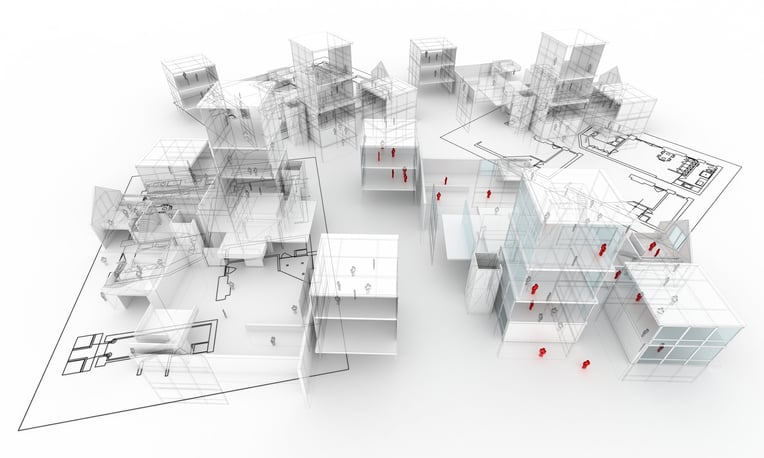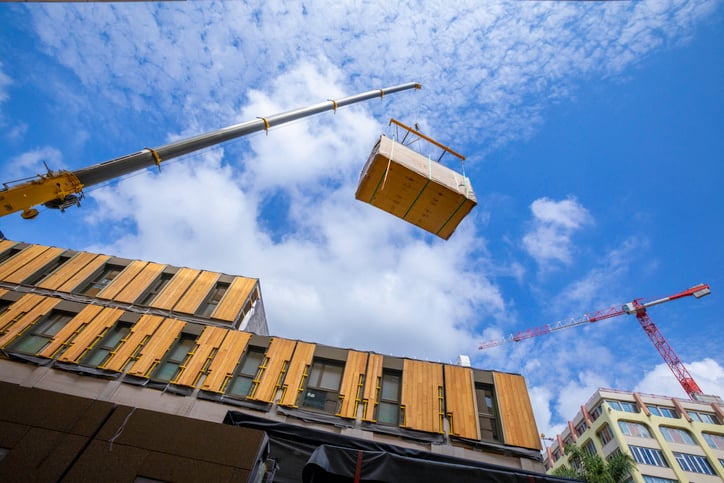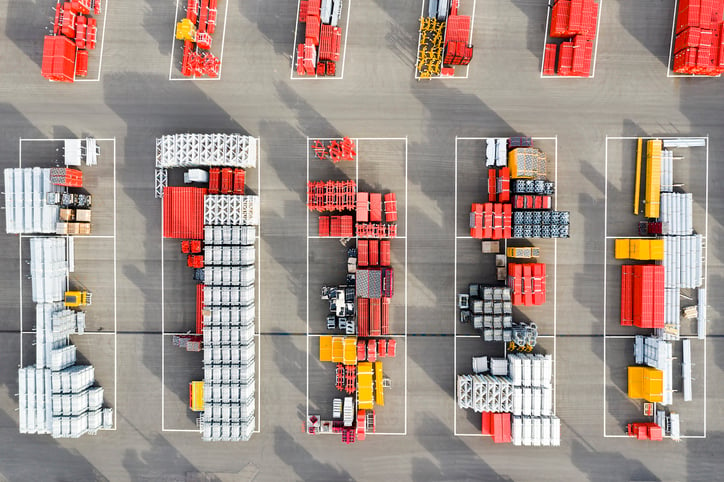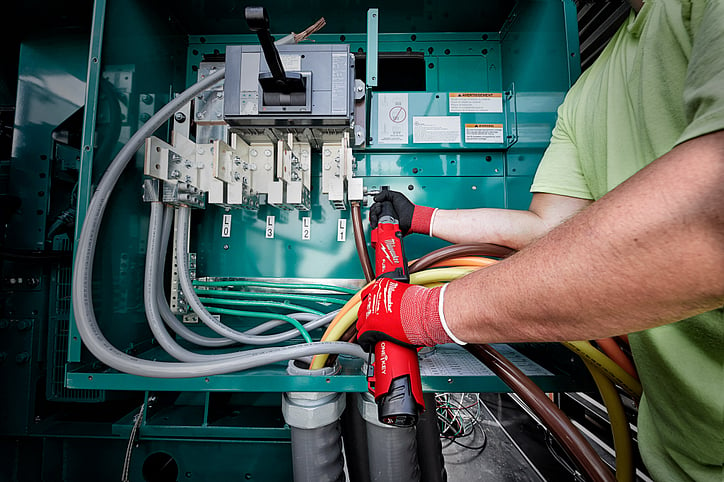What Is Industrialized Construction (IC)? Projects to Products
 The Industrial Revolution gave us manufacturing operations to “reduce production costs by specialized labour and the use of machines appear[ing] in the 18th century in England.” It saw innovations in the textile industry with John Kay’s flying shuttle of 1733, which permitted weaving automation; Edmund Cartwright’s power loom in 1785 that increased weaving speed; James Hargreaves’s spinning jenny in 1764 that spun wool and cotton; Richard Arkwright’s water frame in 1769 that produced cotton thread; and Samuel Crompton’s spinning mule in 1779, a breakthrough needed to produce delicate cotton known as muslin.
The Industrial Revolution gave us manufacturing operations to “reduce production costs by specialized labour and the use of machines appear[ing] in the 18th century in England.” It saw innovations in the textile industry with John Kay’s flying shuttle of 1733, which permitted weaving automation; Edmund Cartwright’s power loom in 1785 that increased weaving speed; James Hargreaves’s spinning jenny in 1764 that spun wool and cotton; Richard Arkwright’s water frame in 1769 that produced cotton thread; and Samuel Crompton’s spinning mule in 1779, a breakthrough needed to produce delicate cotton known as muslin.
Fast forward to 1903, the Ford Motor Company’s first Model T, a vehicle that is now iconic and a museum piece, was so popular then it resulted in the company developing its own application of “mass production” principles, where assembly lines can work in carefully choreographed unison to deliver production efficiency and consistency. Moreover, the now world-famous Toyota Production System, stood up by creator Taichi Ohno, credits Henry Ford as the originator of “Just-In-Time” (JIT) Manufacturing, a critical component of Toyota’s system. This manufacturing and inventory strategy “prioritizes only getting what’s needed to the customer as it’s needed.” However, while Ford has been credited as the originator of JIT, Toyota’s system came off the back of inventor Sakichi Toyoda’s own power loom, and it’s this system that revolutionized the auto industry (as well as wider manufacturing in general)—its impact seen at companies as diverse as airplane manufacturer Boeing and heavy-machinery manufacturer Caterpillar.
But how does mass production fit into building, construction, and professional specialty trades?
Concepts of industrialization in construction have been seen playing out in the construction industry. For example, over 90 US companies have begun adopting some form of IC strategies in the last 23 years, researchers at Stanford University and ETH Zürich found in a joint, preliminary report of emerging trends—a startling upward trajectory since 1994 (4).
With the construction industry plagued by mounting problems—from skilled labor shortages to risk and liability management to inclement weather—industrialized construction (IC) is an emerging management strategy ever-critical to streamlining operations, synchronizing workflows, reducing waste, and achieving optimal efficiency.
In this article, we explore how industrialization of building process may serve as the construction innovation to move the industry forward and away from previously needlessly cumbersome, disjointed, and inherently inefficient practices.
Jump Ahead:
- Industrialized Construction Definition
- Industrial Construction Techniques & Examples
- Impact on Construction
- Industrial Construction Benefits
- What Is the Importance of Industrialized Construction?
Industrialized Construction Definition
Industrialized construction, often shortened to “IC,” is generally described as “the process through which construction aims to improve productivity through increased mechanization and automation.”

It’s worth noting that significant increases in productivity can also be achieved through integration, the removal of existing silos and thinking more systemically across the whole workflow.
In a technical paper for Organization, Technology and Management in Construction, authors Niclas Andersson and Jerker Lessing describe the IC concept as such:
Industrialized construction represents a systematic, controlled, and standardized production process of well-defined elements and building systems, which facilitates the collection of experiences from the design, production, and assembly of the building system as a basis for continuous improvements (1)
In many ways, understanding industrialized construction as a concept begins with changing your very perception of construction as a process. “Fundamentally, [industrialized construction] is about productizing what you build for your customers or for the jobsite,” says Alan Gasvoda, an End User Productivity & Continuous Improvement (CI) Leader here at Milwaukee Tool. “That’s the key component, that you are now building products and no longer just building everything as a one-off the first time you’ve ever built it.” He emphasizes, “It is also about having a consistent process or model by which you build.”
Industrialized construction is a concept that “demonstrates many similar characteristics as the manufacturing industry,” researchers proposing their findings in the academic journal Automation in Construction summarize (Cao et al, 2022).

“Fundamentally, [industrialized construction] is about productizing what you build for your customers or for the jobsite. That’s the key component, that you are now building products and no longer just building everything as a one-off the first time you’ve ever built it. It is also about having a consistent process or model by which you build.”
Alan Gasvoda, End User Productivity & Continuous Improvement (CI) Leader·Milwaukee Tool
Gasvoda agrees. “People view manufacturing as a much more disciplined environment,” he adds. Similarly, “industrialized construction speaks to approaching things in a much more disciplined approach [with] management systems that relay how [work gets] done.”
Industrial Construction Techniques: What Are Some Examples of Industrial Construction?
Just as mass production methods are based on two general principles—(1) the division and specialization of human labor, and (2) the use of tools, machinery, and other equipment, to automate the production of interchangeable parts and products—industrialized construction puts various tools in the hands of contractors, tradespeople, and building professionals to better automate processes and productize building and construction deliverables:
- Prefabrication and Offsite Construction: When talking about industrialized construction at a high level, prefabrication is often the concept that most professionals are most familiar with. If industrialized construction focuses on “really how do you industrialize that construction process,” Gasvoda explains, then it’s finding answers to questions like, “How do I do it in an organized, controlled environment, […] it’s looking to bring as much into that controlled, sequential build environment in a prefab shop.” He adds, “The value of controlled comes to the improved ability to minimize, identify and resolve the variability that is often experienced on the jobsite.” In a nutshell, the concept of prefabrication is one where much of a construction project’s preassembly (e.g., framing and walls) is done inside a factory-like setting to later be delivered and installed onsite. The term “offsite construction,” often used interchangeably, generally encapsulates two related terms, prefabricated construction and modular construction. While modular construction is similar to prefab, it usually differs in that the components that are preassembled are usually more complete, full “modules,” sometimes entire rooms (similar in appearance to shipping containers) that are delivered, usually by flatbed trailer, to site to be installed. Offsite prefabrication can help mediate problems such as skilled labor shortages and environmental factors while also delivering productization benefits (think: factory setting assembly lines, standardized processes, and reliable repeatability that minimize waste while driving consistency).
- Lean Construction: Similar to the “Just-in-Time” manufacturing principles discussed seen at Ford and Toyota, lean construction is an emerging discipline that borrows from lean manufacturing and is a set of business management principles intended to minimize waste and maximize value for all stakeholders. Gasvoda notes that the Lean Construction Institute’s definition of lean construction typically includes “creating a culture of respect for people because Lean is more than just the tools,” adding, “to bring true value for employee stakeholders, it means that I respect them for their ideas and positive action to implement them.”
- Additive Manufacturing: As Autodesk points out, additive manufacturing is commonly known as 3D printing, which can be used within a construction workflow to increase design freedom and timeliness as well as reduce waste.
- Building Information Modeling: “A crucial factor” needed to execute on the benefits IC offers is to “leverage digital fabrication,” write Cao et al, which they describe “combines digital design and advanced manufacturing technologies in a design-to-fabrication workflow.” BIM is essentially smart 3D modeling, which helps deliver comprehensive digital representation of entire construction projects from top to bottom. When used with LiDAR, professionals and stakeholders can collaborate virtually, envisioning finished products in their natural environment.
- Big Data, Predictive Analytics, and Digital Twins: Shocking findings revealed that a whopping 95% of data captured in the construction and engineering industry goes unused (FMI via Autodesk). There is ample data that firms can pull from—leveraging proper construction data management and building integrations can better synchronize the digital tools used across your organization and eliminate information silos. Responsible uses of data modeling and artificial intelligence can help you create digital representations of projects, similar to how a factory can visually monitor, diagnose, and predict how a piece of machinery is functioning and how one small cog in the machine may need to be repaired before bringing the whole line to a screeching halt.
- Robotics: The science of robotics is a rapidly growing discipline within engineering (some universities even have full-fledged majors dedicated to it). Suffice it to say, there are genuinely useful applications for robotics—just as advanced robotics machinery in manufacturing can be used to streamline operations while upskilling workers into higher-demand roles, construction robots can be used for everything from demoing sites to laying bricks to wearable exoskeletons that assist workers to robotic drones. Above all, these robots on jobsites are used in the assistance of human tradespeople, often automating monotonous and oftentimes dangerous task that have long needlessly put professional workers in harm’s way.
- Internet of Things and Smart Power Tools: The Internet of Things has birthed everything from smart HVAC systems that drive sustainability, to community tracking that helps you find your misplaced drill, smart power tools that can be locked out when stolen; alert their owners when they’re due for service; customized for reliable repeatability in specialized applications; or, similar to the robots that automate dangerous installations, processes can be streamlined to avoid repetitive motion injuries while synchronizing installation data for quality assurance purposes.
IC: Impact on Construction
The impact on construction IC has, by and large, is a mostly positive one. For example, in their 2019 report, McKinsey & Company proposes a shift “from projects to products” could have “potential for profound impact” to accelerate project timelines by 20 to 50%.
 However, as Gasvoda notes, industrializing can also introduce an element of risk for some contractors. “It’s a big change from the way that contractors have to think and operate,” he explains. When adopting prefab, just one example of an IC technique, he explains, “It forces another layer of complexity to materials management.” He adds, “They may need to buy things before they’re going to need them, further in advance from when they’re going to get paid to install them,” which may introduce risk, where they’ll need to ask, “What’s my materials strategy such that there are certain things I need to get well in advance?”
However, as Gasvoda notes, industrializing can also introduce an element of risk for some contractors. “It’s a big change from the way that contractors have to think and operate,” he explains. When adopting prefab, just one example of an IC technique, he explains, “It forces another layer of complexity to materials management.” He adds, “They may need to buy things before they’re going to need them, further in advance from when they’re going to get paid to install them,” which may introduce risk, where they’ll need to ask, “What’s my materials strategy such that there are certain things I need to get well in advance?”
“Prefab adds a level of complexity,” Gasvoda emphasizes, clarifying “which is further complicated with the current supply chain issues today. This perfect storm introduces even more risk which means contractors should review their materials strategy.”
That said, he notes that adopting prefab can put contractors at an advantage, having materials in house and under their control. “When done correctly with the right information, you’re going to have less waste throughout the process,” he explains. “When done right, prefab allows for the right flow of materials to the jobsite, which allows you to have a better predictability and control when you need a material and how you get it to the jobsite.”
Industrial Construction Benefits
A McKinsey study predicted that the construction sector could potentially save $20 billion in cost and 50% in time annually through the adoption of industrialized construction.

Some of the key industrial construction benefits are as follows:
- Increasing labor productivity
- Reducing cost and risk associated with construction
- Substituting labor-intensive processes with machines, automation, and industrial techniques (like manufacturing principles)
- Expediting preassembly and minimizing delays
- Improving overall quality and sustainability
- Delivering affordability and customization
- Improving safety
- Improving the quality of the finished product
- Enhanced productivity through optimization and automation
- Improved scalability and flexibility
What Is the Importance of Industrialized Construction?
Industrialization is just as important to construction as it was critical to driving that processes that revolutionized the manufacturing industry, bringing us the Model T and more recently electrification that’s got the backing of the U.S. government (and a $7.5 billion investment to build out a nationwide charging network).

City governments in prominent U.S. states (e.g., San Francisco, Vancouver, WA, and New York City) have expressed great interest in IC (4), primarily driven by the nationwide affordable housing crisis, while globally in London and other districts in the UK “have already used government-driven partnerships with industrialized construction companies to rapidly produce housing in areas of notable growth.” In large part due to its speed, repeatability, affordability, and productization reliability, IC is being looked at as the solution to address housing concerns.
Bottom Line
Industrialization of building process is poised to be the modern-day equivalent to the industrial revolution that brought us reliable and repeatable processes on the assembly line.
The concept of industrialized construction may be a challenging one for contractors to wrap their heads around because it involves changing their perception from one-off building projects they may be used to, to a mindset of product management. A contractor who’s adopted IC, Gasvoda tells me, is one who has “Management systems that overlay how I get things done.”
“There are still so many contractors that do things the way they’ve always done it,” Gasvoda explains. IC requires “a certain cadence and discipline about how I execute work.”
“It brings rigor to the planning process of how things get done, he adds, “Rigor to the daily execution of that work and the daily problem solving that goes along with when things don’t go to plan.”
There are challenges involved when moving from a one-off “project” mindset to a productization strategy. But gradually adopting management systems and principles that overlay the work you execute can bring benefits that both you and your customers can enjoy. The cost savings from eliminated waste and the better finished product you deliver will keep your customers happy. But what’s more, they’ll also give you a product you’re pleased to sign your name to.
References
- Andersson, N and Lessing, J. Industrialization of construction: Implications on standards, business models and project orientation. (2020). Organization, Technology and Management in Construction, 11, 2109-2116. https://hrcak.srce.hr/file/353380
- Cao, J., Edlira, V., Soman, and R, Hall, D. (2022). Ontology-based manufacturability analysis automation for industrialized construction. Automation in Construction. https://www.sciencedirect.com/science/article/pii/S0926580522001509
- McKinsey & Co. (2019). Modular construction: from projects to products. https://www.mckinsey.com/capabilities/operations/our-insights/modular-construction-from-projects-to-products
- Pullen, T, Hall, D, and Lessing, J. (2019). A preliminary overview of emerging trends for industrialized construction in the United States [White paper]. ETH Zurich. https://www.research-collection.ethz.ch/bitstream/handle/20.500.11850/331901/2/PullenHallLessing-2019-WhitePaperAPreliminaryOverviewofEmergingTrendsforIndustrializedConstructionintheUnitedState.pdf

About the Author
Lucas is Content Marketing and SEO Manager for Milwaukee Tool, where he and his team raise awareness about the company’s digital products and educate users on best practices through a variety of content vehicles. More Content By Lucas MarshallSubscribe to Our Blog
Sign up to receive ONE-KEY™ news and updates.
Recent Articles
Essential Strategies for Balancing Work and Life in Construction
Editorial Note: This article was brought to you courtesy of Rose Morrison, managing editor of ...
Maximizing Efficiency: Do Roofing and Scaffolding Specialists Need Construction Software?
Editorial Note: This article was brought to you courtesy of Rose Morrison, managing editor of ...
11 Advancements Women in Construction Have Made So Far This Year
Editorial Note: This article was brought to you courtesy of Rose Morrison, managing editor of ...



